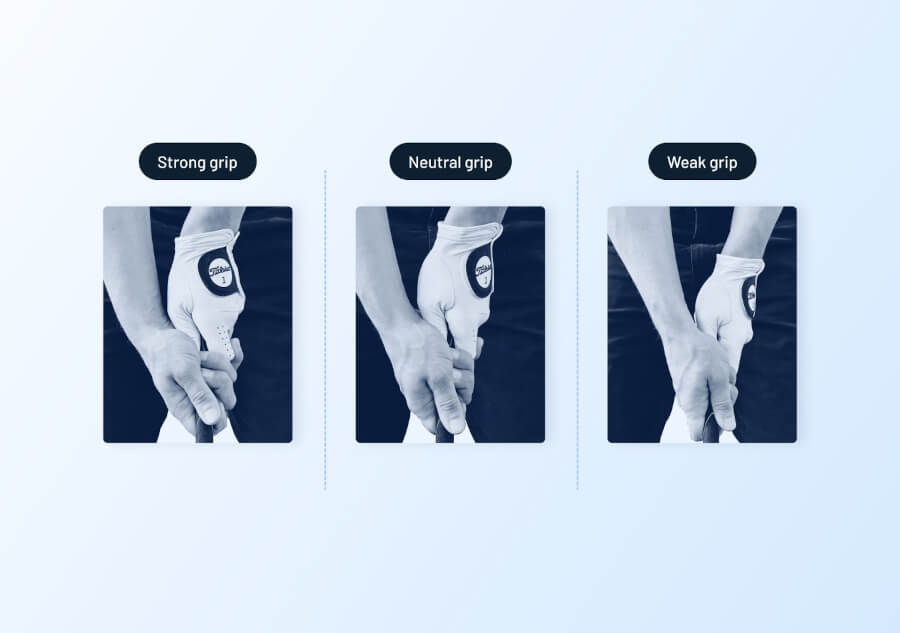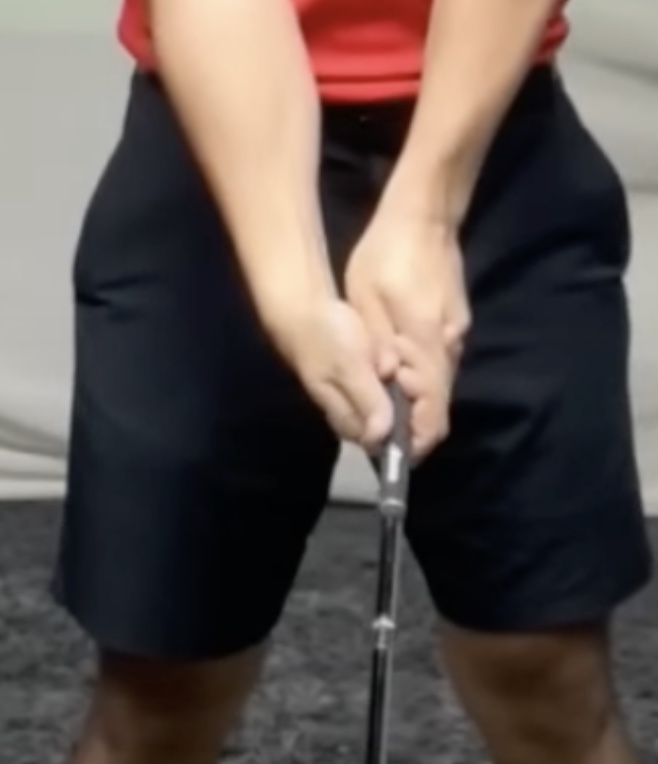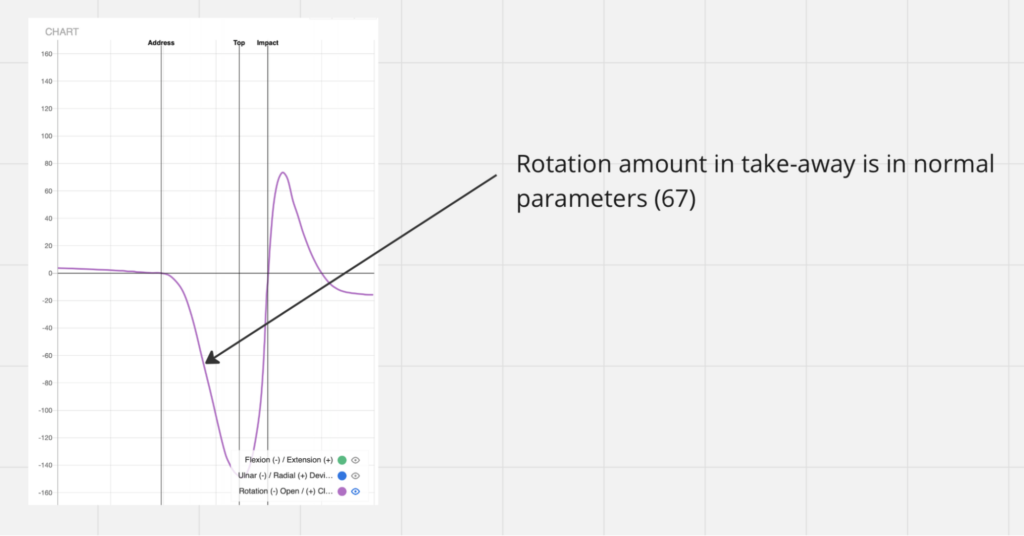Are you struggling to achieve the desired range at the top of your golf swing and finding yourself plagued by excessive wrist extension?
This is a common issue that can significantly impact the quality of your swing. Excessive wrist extension at the top of your swing can lead to an open clubface and generally steepens the shaft, making it challenging to square it during the downswing. In this article, we will explore the common issues leading to this problem and provide solutions to help you improve your golf swing.
1. Start with Checking the Grip
One of the primary reasons for excessive wrist extension is often an improper grip that doesn’t suit your particular swing style. Your grip directly affects your wrist’s position and flexibility during the swing. There are two key grip issues to address: Weak lead grip and weak trail grip.
Weak Lead Grip
A weak lead grip promotes an open clubface and often requires a more flexed wrist position, which can be challenging for many players. To identify a weak lead grip, check if the back of your hand faces more towards the target or if the “V” shape between your thumb and index finger points more towards your lead shoulder. As opposed to a stronger grip where fingers point to the opposite side.
During the swing when moving from Address to Top position, it will be a lot easier to flex your wrist by 10 degrees or keep the same angle from 20-30 degrees of extension than doing it from 5-10 degrees of extension. Players with a weak lead grip have to work harder to flex their lead wrist in order to get their club more closed.
NOTE: In addition to the grip adjustments mentioned, it’s essential to ensure that you hold the club using your fingers rather than positioning it deep inside your palm. Utilizing your fingers for grip provides enhanced control over the club’s movement and positioning.

How To Identify a Weak Lead Grip?
If you notice in the HackMotion data that your address position consistently remains around or below 0, it’s a sign that you should investigate your grip. Addressing your grip and making it stronger may resolve the issue of excessive extension at the top of your swing.
How To Fix a Weak Lead Grip?
– Place the club in the fingers of your left hand with your fingers pointing downwards.
– The grip of the club should run from the middle of the index finger to the base of the little finger.
– Ensure that the line between your thumb and index finger points to your trail shoulder.
Start by slightly strengthening your lead wrist grip, but be cautious not to make it too strong. A stronger grip will help close the clubface, which can benefit players prone to pushes and slices but may be detrimental if you tend to pull the ball.
Weak Trail Grip
A weak trail hand grip can make it difficult to flex your lead wrist during your swing and may make you feel “restricted” when trying to do so. To identify a weak trail grip, check if the “V” between your trail hand’s thumb and index finger points towards your lead shoulder.

The “V” shape formed by the thumb and index finger of your trail hand should be directed toward your lead shoulder.

The “V” shape created by the thumb and index finger of your trail hand should be oriented towards your trail shoulder.
How To Fix a Weak Trail Grip?
– Work on strengthening your trail hand grip.
– A stronger trail wrist makes it easier to achieve a more flexed wrist position at the Top of your swing.
2. Check The Takeaway
In the HackMotion swing graph, the takeaway phase corresponds to approximately the first 45% of the backswing.
The takeaway phase in your golf swing is crucial, as it sets the stage for the rest of your swing. Two issues related to the takeaway can contribute to excessive wrist extension: Inside takeaway and extension in takeaway.
Inside Takeaway
An inside takeaway can make you feel “stuck” and lead to the natural extension of your wrists as you try to complete your backswing. This can occur in three ways:
- through early flexion in the takeaway,
- by rolling your wrists (rotating) during the takeaway, or
- through body rotation with flat shoulder plane
How To Identify an Inside Takeaway?
1. Using HackMotion observe:
- if there is a significant drop in extension during your takeaway, indicating you are taking the club inside through flexion. If a player drops to more than 10 degrees in flexion in their takeaway we consider that as in inside takeaway.

- If there is too much wrist rotation in the takeaway, which can take your club too much behind you. If you observe wrist rotation in the range of 80-90 degrees, you are at a medium risk for an inside takeaway. However, if you measure it exceeding 90 degrees, then there is a high risk for having an inside takeaway as your issue for Top extension.
2. Additionally, you can try to record yourself from down the line view. If during your takeaway you see the clubhead going behind your body your taking it inside far too much

How To Fix an Inside Takeaway?
Use specific drills designed to address an inside takeaway:
- The drill for the flexion inside takeaway:
- The drill for the rotational inside takeaway:
Extension In Takeaway
If you notice that you are cupping our wrists or rotating them aggressively during the takeaway, this can lead to added wrist extension.
How To Identify Extension in Takeaway?
Check if there is an added extension by more than 5 degrees from your address position during the takeaway. If yes, then this is the issue to focus on.
How To Fix Extension in Takeaway?
In order to fix this wrist issue, practice drill with a focus on maintaining flexion.
3. Check Your Ulnar/Radial Values
If the takeaway is not the issue, it’s essential to ensure that you are not over-hinging your wrists. Wrist hinge, also known as radial deviation, is a common factor contributing to increased wrist extension. This is often observed when golfers aim to create a “lag” in their club’s motion by introducing excessive wrist hinge during their backswing.
Wrist Hinge
Currently, the most effective method for gauging this is to examine the uln/rad change between the address and the highest point in your backswing till the top of the swing, ensuring it does not exceed 35 degrees. If it does surpass this threshold, it indicates that the player needs to focus on refining their wrist hinge.
Additionally, golfers with shorter backswings, particularly those who struggle with rotation and completing their backswing, tend to increase wrist hinge as a means to “lengthen” their swing. It’s worth noting that radial deviation makes it significantly more challenging to achieve wrist flexion during the swing.
How To Identify Wrist Hinge?
1. To assess this, record your swing from a face-on perspective and carefully observe whether you are introducing excessive wrist hinge during your backswing. A desirable goal for most players is to maintain an “L” shape between their wrists and forearms.


2. Utilizing HackMotion data, analyze your ulnar deviation from the address position to the Top of your backswing and ensure it does not exceed 35 degrees.
How To Fix Wrist Hinge?
- Try the wrist pre-set drill. The same drill as for the Extension Takeaway (see above).
4. Other Possible Issues
If none of the previously mentioned issues seem to apply to your case, it’s worth exploring two additional factors that can contribute to excessive wrist extension: Internal trail shoulder rotation or if the player simply is not flexing enough for some other reason.
Internal Trail Shoulder Rotation
During your backswing, if your trail shoulder starts to rotate towards your body, it can naturally add extension to your lead wrist.
How To Identify Internal Trail Shoulder Rotation?
Capture a video of your swing from a down-the-line perspective and pay close attention to whether your elbows are drifting apart during your backswing. If yes, then this is the issue for you to fix.


How To Fix Internal Trail Shoulder Rotation?
Consider trying the “Waiter drill” in order to fix this issue.

During your backswing, envision that you are carrying a tray of drinks with your right (trail) arm as though you were a waiter. To do this, follow these steps:
1. Begin by setting up as you typically would for a golf shot.
2. Visualize your imaginary golf club and initiate the swing, mirroring your usual takeaway and backswing.
3. As you reach the top of your swing in your mind’s eye, examine your right (trail) hand’s position for these key attributes:
- Ensure your right elbow maintains a slight bend, slightly more than 90 degrees.
- Your right wrist should be bent at an approximately 90-degree angle.
- Your right hand should be pointed upward, towards the sky
- Confirm that your right elbow is positioned below the level of your right shoulder.
This mental exercise can help you achieve an ideal top-of-swing position, promoting a more effective and controlled golf swing.
Simply Not Flexing Enough At Top
If the player simply is not flexing enough for some other reason, in those cases the best we can do is offer some drills to get a feel for better flexion at the Top (i.e. Motorcycle drill).
Final Words
In conclusion, identifying and rectifying issues with excessive wrist extension at the top of your golf swing is crucial for improving your game. By addressing your grip, takeaway, uln/rad values, and other potential contributing factors, you can work towards a more controlled and effective golf swing.